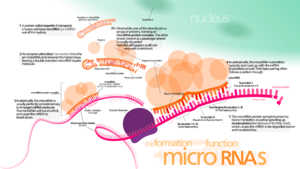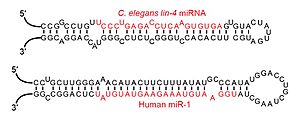- This page was last modified on 17 October 2025, at 10:18. Suggest an edit.
microRNA facts for kids
MicroRNA (often called miRNA or µRNA) are tiny, single-strand molecules. They are a type of non-coding RNA, meaning they don't carry instructions to make proteins. Each miRNA is only about 21 to 23 nucleotides long.
You can find miRNAs in plants, animals, and even some viruses. They play a big role in controlling how our genes work. They do this by a process called RNA silencing. This means they can "silence" or turn down the activity of other RNA molecules called mRNA.
Here's how miRNAs usually work:
- They stick to specific mRNA molecules.
- Then, they can stop the mRNA from making proteins. They do this by:
* Breaking the mRNA into two pieces. * Making the mRNA unstable so it falls apart faster. * Stopping the mRNA from being translated into proteins.
In humans and other animals, miRNAs mostly work by making mRNA molecules unstable.
miRNAs are similar to small interfering RNAs (siRNAs). Both are part of a system called RNA interference (RNAi). But miRNAs come from RNA that folds into a hairpin shape. SiRNAs come from longer, double-stranded RNA.
Scientists think the human genome might have over 1900 different miRNAs. About 500 of these are well-known and studied.
MiRNAs are found in many types of cells in mammals. They seem to control about 60% of the genes in humans and other mammals. Many miRNAs are very old in terms of evolution. This means they have important jobs. For example, 90 families of miRNAs have been the same since fish and mammals shared a common ancestor. Studies in mice show these miRNAs are very important.
The discovery of miRNA and its role in controlling genes happened in the early 1990s. American scientists Victor Ambros and Gary Ruvkun made this discovery. They won the 2024 Nobel Prize in Physiology or Medicine for their work.
Contents
How MicroRNA Was Discovered
The first miRNA was found in 1993. But scientists didn't realize how important they were until the early 2000s. Research then showed that different cells and tissues have different miRNAs. They also found that miRNAs are important for how plants and animals grow. They are also involved in many other body processes.
Scientists also learned that problems with miRNAs can lead to diseases. Now, researchers are looking into using miRNA-based treatments for illnesses.
The first miRNA was found by a team led by Victor Ambros in 1993. At the same time, Gary Ruvkun's team also published important work. Both groups published papers about a gene called lin-4. This gene was known to control the timing of development in a tiny worm called C. elegans. It did this by stopping another gene called lin-14.
When Ambros's team found the lin-4 miRNA, they saw something new. Instead of making a protein, it made short non-coding RNAs. One of these was a tiny RNA, about 22 nucleotides long. This small RNA could stick to parts of the lin-14 mRNA. Scientists thought this sticking stopped the lin-14 mRNA from making the LIN-14 protein. At first, scientists thought this tiny RNA was only special to this type of worm.
In 2000, another small RNA was found. It was called let-7 RNA. This RNA also helped control development in C. elegans. Scientists found that let-7 RNA was present in many different species. This made them think that let-7 and other "small temporal RNAs" might control development in many animals, including humans.
A year later, scientists realized that lin-4 and let-7 RNAs were part of a large group of small RNAs. These were found in C. elegans, Drosophila (fruit flies), and human cells. Many of these RNAs were like lin-4 and let-7. But their patterns of activity suggested they did more than just control development timing. This is when researchers started using the term "microRNA" for this group of small RNAs.
The first human disease linked to problems with miRNAs was chronic lymphocytic leukemia. In this disease, miRNAs can act in two ways. They can either stop tumors from growing or help them grow.
See also
 In Spanish: Micro-ARN para niños
In Spanish: Micro-ARN para niños
- Anti-miRNA oligonucleotides
- C19MC miRNA cluster
- Gene expression
- List of miRNA gene prediction tools
- List of miRNA target prediction tools
- MicroDNA
- MicroRNA Biosensors
- MiRNEST
- MIR222
- miR-324-5p
- Mir-M7 microRNA precursor family
- RNA interference
- Small interfering RNA
- Small nucleolar RNA-derived microRNA


